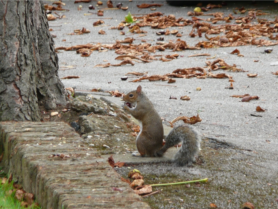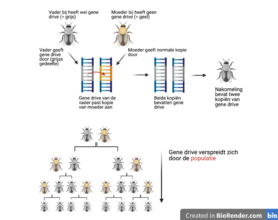Ecosystems become unbalanced when local animal species disappear or invasive (exotic) species take over. For example, the increase in the number of invasive grey squirrels in the UK is a threat to the local red squirrel population. They also prey on chicks and eggs and damage trees. A recent study from Scientific Reports shows that the so-called Gene Drive technology offers a possible solution. This technology changes the building blocks of the DNA and ensures the spread of these genetic modifications throughout an entire population. By spreading Gene Drives in the gray squirrel population, resulting in fewer offspring, this population can be contained. This is just one example of the possible applications of the Gene Drive technique to restore the balance in ecosystems. What are other applications? And how can it intervene at the population level? What are the risks? And are you going to deal with this technique in the future?
 Figure 1 – Grey squirrel in United Kingdom. Source: pixabay.com Applications of Gene Drives
In the example of the grey squirrels, researchers at the University of Edinburgh tested the spread of the Gene Drives with computer models. Not yet in real squirrels. Other ecosystem restoration applications focus on the genetic modification of endangered species. Certain frog species, for example, so that they can better resist a threatening fungus.
The most radical Gene Drives can wipe out an entire population. For example, the invasive black rats in New Zealand that threaten plants and various animal species such as snails, insects, reptiles and birds. Or the malaria mosquito that threatens honeycreepers in Hawaii, using a Gene Drive that ensures that only male mosquitoes are born.
The examples mentioned are theoretical applications, of which the actual development will probably take years. They do, however, show the great possibilities of the technology.
How Gene Drives Work
But how does that technology work? For this we have to go back to the basics of heredity. You have two copies of each gene: one from your father and one from your mother. A Gene Drive is a piece of DNA that, in the case of the honey bee example in Figure 2, codes for the color grey. A honey bee can be genetically modified by sticking this Gene Drive in the middle of a gene. If the Gene Drive is in the copy of the father, but not in the copy of the mother, the Gene Drive will recognize the “normal”, yellow copy of the mother and copy itself there. The yellow copy is thus destroyed and replaced by the grey Gene Drive copy. The result: the copy of the father and the mother both contain the Gene Drive. This will make their offspring grow into a grey honey bee (see figure 2).
 Figure 2 – How Gene Drives work If these offspring were to mate in the wild with a normal yellow honey bee, the same story repeats itself. Their descendants also contain two Gene Drive copies. The chance that the Gene Drive will be passed on is therefore almost 100%, from generation to generation. Thus, this technique is able to adapt an entire population over time, regardless of the evolutionary advantage or disadvantage of the Gene Drive.
An unfavorable genetic trait would normally be extinguished in the population through crossing and selection, but not for Gene Drives. There, when crossed, the normal, “good” genetic trait is destroyed, replaced by the evolutionary unfavorable Gene Drive and passed on to the next generation.
Risks
Genetic adaptation at the population level to conserve ecosystems also entails risks for ecosystems. For example, if an invasive species is eradicated, other animal species may regain the upper hand, or other species may have less to eat, causing them to hunt other animals. Another risk is the rapid spread of Gene Drives. Carina Nieuwenweg, researcher into Gene Drives at Wageningen University and Research, compares Gene Drives to a pregnancy: “you are pregnant or not. The same goes for how scientists look at Gene Drives: they are out there or not. Once released into the wild, they spread very quickly and can end up in populations you don’t want to adapt.”
These risks do not make everyone equally enthusiastic about the technology. Last summer, 78 environmental organizations argued for a ban on Gene Drive technology because of concerns for further decline in biodiversity. Ecologists and geneticists must therefore be able to estimate and contain the risks that the release of Gene Drives entail for ecosystems as accurately as possible. Nieuwenweg conducts research into so-called “reversible” drives, genetic elements that could stop the spread of Gene Drives. This way you can control the spread, which reduces the risks.
Ethics
Not only risks, but also ethical issues arise as a result of the technology. Are we as humans allowed to intervene with nature that much? As Mufasa said to Simba in the Lion King, “you must take your place in the Circle of Life”, but don’t we take up too much place as humans when we introduce the Gene Drive technology?
 Source: pixabay.com Future
At the moment, it is only allowed to use Gene Drives inside laboratories, not to release them outside. Will the Gene Drives ever be released into the wild to save key players within an ecosystem? This will probably take years. According to Nieuwenweg: “When we (science) have developed a good system to control the spread of Gene Drives, it is certainly a promising technology that can help manage ecosystems. But as a human you are managing the ecosystem, instead of letting it run its course. You have to be aware of that.”
A technique with many possibilities, those Gene Drives. But also a technique that raises many questions that we as a society have to think about. What do you think of this technique? Let me know in the comments below! |